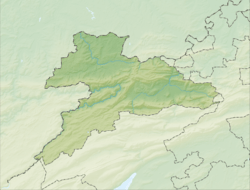Grandfontaine, Switzerland facts for kids
Quick facts for kids
Grandfontaine
|
||
|---|---|---|
|
||
| Country | Switzerland | |
| Canton | Jura | |
| District | Porrentruy | |
| Area | ||
| • Total | 8.97 km2 (3.46 sq mi) | |
| Elevation | 529 m (1,736 ft) | |
| Population
(Dec 2020 )
|
||
| • Total | 387 | |
| • Density | 43.14/km2 (111.74/sq mi) | |
| Demonym(s) | Gueillemetins | |
| Postal code |
2908
|
|
| Localities | Grandfontaine | |
| Surrounded by | Damvant, Réclère, Roche-d'Or, Rocourt, Fahy, Abbévillers(F), Glay(F), Dannemarie(F) | |
Grandfontaine is a small town, also called a municipality, located in the Jura canton of Switzerland. It is part of the Porrentruy district. The name "Grandfontaine" means "large fountain" in French. This name comes from a big natural spring and a bath house built in the 1800s, which are still important parts of the village today.
Contents
A Glimpse into Grandfontaine's Past
Grandfontaine is an old settlement. The first time it was ever written about was in the year 1136. Back then, it was known as Granfontana.
Exploring Grandfontaine's Geography
Grandfontaine covers an area of about 8.94 square kilometers (3.45 square miles). A big part of this land, about 64.4%, is used for farming. This means there are lots of fields and pastures. Forests cover about 28.3% of the area, providing green spaces and wildlife habitats.
About 6.7% of the land is built up with buildings and roads. The rest, a tiny 0.2%, is land that isn't used for farming or building. The town is nestled in a small valley. It's located near the main road that connects Porrentruy in Switzerland to Besançon in France.
What Does Grandfontaine's Coat of Arms Look Like?
A coat of arms is like a special symbol or logo for a town or family. Grandfontaine's coat of arms has a black cross in the middle. Around the cross, there are 20 small black rectangles, called billets. The background color of the shield is gold.
Who Lives in Grandfontaine?
Grandfontaine has a population of about 345 people. Most people in Grandfontaine speak French as their main language. About 91% of the residents speak French. German is the second most common language, spoken by about 8.5% of the population.
In 2008, a little more than half of the population (52.1%) were women, and 47.9% were men. Most people living in Grandfontaine were born there or in the same canton (region). About 27% of the population are children and teenagers (under 20 years old). Adults (20-64 years old) make up about 57%, and seniors (over 64 years old) are about 16%.
Most households in Grandfontaine have about 2.5 people living in them. There are also some households where only one person lives.
How Has Grandfontaine's Population Changed Over Time?
The number of people living in Grandfontaine has changed over many years.
- In 1818, there were 395 people.
- The population grew to 471 by 1850.
- After that, the population slowly went down.
- By 1980, it was 306 people.
- In 2000, the population was 330.
Grandfontaine's Economy and Jobs
In 2010, the unemployment rate in Grandfontaine was quite low, at 2.7%. This means most people who wanted to work had jobs.
What Kinds of Jobs Do People Have?
Many people in Grandfontaine work in three main types of jobs:
- Primary Sector: This includes jobs like farming. About 44 people work in this area, with 16 businesses.
- Secondary Sector: This involves making things or building. About 36 people work in this sector, with 9 businesses. This includes manufacturing and construction.
- Tertiary Sector: This is about services. About 37 people work here, with 10 businesses. This includes jobs in sales, hotels, restaurants, and education.
In 2008, there were 94 full-time jobs in Grandfontaine. Many people who live in Grandfontaine travel to other towns for work. About 57% of workers use a private car to get to their jobs.
Religious Life in Grandfontaine
Based on information from 2000, most people in Grandfontaine are Roman Catholic, making up about 85% of the population. A smaller group, about 5.8%, belong to the Swiss Reformed Church. Some people belong to other Christian churches, and a few do not belong to any church.
Learning and Education in Grandfontaine
In Grandfontaine, about 33% of the adults have finished high school (called upper secondary education). About 9% have gone on to higher education, like university.
How Does the Swiss School System Work?
The school system in the Canton of Jura, where Grandfontaine is located, works like this:
- Kindergarten: Children can attend two years of non-required kindergarten.
- Primary School: This is followed by six years of primary school, which everyone must attend.
- Lower Secondary School: After primary school, students go to three years of lower secondary school. Here, students might be grouped based on their abilities.
- Upper Secondary School: After lower secondary school, students can choose to go to an optional three or four-year upper secondary school. From there, they can go to university or start an apprenticeship to learn a trade.
In the 2009-2010 school year, no students were attending school directly in Grandfontaine itself. However, students from Grandfontaine attend schools in nearby towns.
See also
 In Spanish: Grandfontaine (Jura) para niños
In Spanish: Grandfontaine (Jura) para niños





